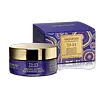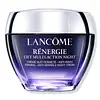What's inside
What's inside
 Key Ingredients
Key Ingredients

 Benefits
Benefits

 Concerns
Concerns

 Ingredients Side-by-side
Ingredients Side-by-side

Water
Skin ConditioningCocos Nucifera Oil
MaskingDecyl Oleate
EmollientCaprylic/Capric Triglyceride
MaskingC12-15 Alkyl Benzoate
AntimicrobialGlycerin
HumectantCetyl Alcohol
EmollientDicaprylyl Carbonate
EmollientCetearyl Glucoside
EmulsifyingCetyl Palmitate
EmollientButyrospermum Parkii Butter
Skin ConditioningGlyceryl Stearate
EmollientDimethicone
EmollientPanthenol
Skin ConditioningHydroxyacetophenone
AntioxidantParfum
MaskingPassiflora Edulis Seed Oil
EmollientTocopheryl Acetate
Antioxidant1,2-Hexanediol
Skin ConditioningAcrylates/C10-30 Alkyl Acrylate Crosspolymer
Emulsion StabilisingCaprylyl Glycol
EmollientHydroxypropyl Guar
Emulsion StabilisingPistacia Lentiscus Gum
MaskingPropylene Glycol
HumectantDimethiconol
EmollientPersea Gratissima Oil
Skin ConditioningSodium Carboxymethyl Betaglucan
Sodium Phytate
Retinyl Palmitate
Skin ConditioningSodium Hydroxide
BufferingSodium Hyaluronate
HumectantSodium Stearoyl Glutamate
CleansingHelianthus Annuus Seed Oil
EmollientBenzyl Salicylate
PerfumingHexyl Cinnamal
PerfumingQuartz
AbrasiveLinalool
PerfumingCoumarin
PerfumingAlpha-Isomethyl Ionone
PerfumingCitronellol
PerfumingBHA
AntioxidantBHT
AntioxidantLimonene
PerfumingCitric Acid
BufferingPropyl Gallate
AntioxidantCI 19140
Cosmetic ColorantCI 15985
Cosmetic ColorantCI 16035
Cosmetic ColorantCI 42090
Cosmetic ColorantWater, Cocos Nucifera Oil, Decyl Oleate, Caprylic/Capric Triglyceride, C12-15 Alkyl Benzoate, Glycerin, Cetyl Alcohol, Dicaprylyl Carbonate, Cetearyl Glucoside, Cetyl Palmitate, Butyrospermum Parkii Butter, Glyceryl Stearate, Dimethicone, Panthenol, Hydroxyacetophenone, Parfum, Passiflora Edulis Seed Oil, Tocopheryl Acetate, 1,2-Hexanediol, Acrylates/C10-30 Alkyl Acrylate Crosspolymer, Caprylyl Glycol, Hydroxypropyl Guar, Pistacia Lentiscus Gum, Propylene Glycol, Dimethiconol, Persea Gratissima Oil, Sodium Carboxymethyl Betaglucan, Sodium Phytate, Retinyl Palmitate, Sodium Hydroxide, Sodium Hyaluronate, Sodium Stearoyl Glutamate, Helianthus Annuus Seed Oil, Benzyl Salicylate, Hexyl Cinnamal, Quartz, Linalool, Coumarin, Alpha-Isomethyl Ionone, Citronellol, BHA, BHT, Limonene, Citric Acid, Propyl Gallate, CI 19140, CI 15985, CI 16035, CI 42090
Water
Skin ConditioningGlycerin
HumectantPrunus Armeniaca Kernel Oil
MaskingCaprylic/Capric Triglyceride
MaskingPentaerythrityl Tetraethylhexanoate
EmollientCetyl Alcohol
EmollientZea Mays Starch
AbsorbentButyrospermum Parkii Butter
Skin ConditioningAlcohol Denat.
AntimicrobialPetrolatum
EmollientPentylene Glycol
Skin ConditioningGlyceryl Stearate
EmollientDimethicone
EmollientPEG-40 Stearate
EmulsifyingCera Alba
EmollientHydroxyethylpiperazine Ethane Sulfonic Acid
BufferingCI 14700
Cosmetic ColorantCI 19140
Cosmetic ColorantSaccharomyces/Xylinum/Black Tea Ferment
Skin ConditioningHydrolyzed Linseed Extract
Skin ConditioningHydrolyzed Soy Protein
HumectantHydrolyzed Hyaluronic Acid
HumectantSodium Hydroxide
BufferingSodium Benzoate
MaskingPhenoxyethanol
PreservativeAdenosine
Skin ConditioningStearyl Alcohol
EmollientAcetyl Tetrapeptide-9
Skin ConditioningPoloxamer 338
EmulsifyingDimethiconol
EmollientLimonene
PerfumingXanthan Gum
EmulsifyingPentaerythrityl Tetra-Di-T-Butyl Hydroxyhydrocinnamate
AntioxidantBenzyl Alcohol
PerfumingCaprylyl Glycol
EmollientAlpha-Isomethyl Ionone
PerfumingSorbitan Tristearate
EmulsifyingMyristyl Alcohol
EmollientGeraniol
PerfumingHexyl Cinnamal
PerfumingParfum
MaskingWater, Glycerin, Prunus Armeniaca Kernel Oil, Caprylic/Capric Triglyceride, Pentaerythrityl Tetraethylhexanoate, Cetyl Alcohol, Zea Mays Starch, Butyrospermum Parkii Butter, Alcohol Denat., Petrolatum, Pentylene Glycol, Glyceryl Stearate, Dimethicone, PEG-40 Stearate, Cera Alba, Hydroxyethylpiperazine Ethane Sulfonic Acid, CI 14700, CI 19140, Saccharomyces/Xylinum/Black Tea Ferment, Hydrolyzed Linseed Extract, Hydrolyzed Soy Protein, Hydrolyzed Hyaluronic Acid, Sodium Hydroxide, Sodium Benzoate, Phenoxyethanol, Adenosine, Stearyl Alcohol, Acetyl Tetrapeptide-9, Poloxamer 338, Dimethiconol, Limonene, Xanthan Gum, Pentaerythrityl Tetra-Di-T-Butyl Hydroxyhydrocinnamate, Benzyl Alcohol, Caprylyl Glycol, Alpha-Isomethyl Ionone, Sorbitan Tristearate, Myristyl Alcohol, Geraniol, Hexyl Cinnamal, Parfum
Ingredients Explained
These ingredients are found in both products.
Ingredients higher up in an ingredient list are typically present in a larger amount.
Alpha-Isomethyl Ionone is a fragrance. It can be synthetically created or naturally occurring.
The scent of Alpha-Isomethyl Ionone is described as "flowery" but can also be "woody".
Naturally occurring Alpha-Isomethyl Ionone may be found in Saccharomyces cerevisiae, or the yeast used to make wine and bread.
The term 'fragrance' is not regulated in many countries. In many cases, it is up to the brand to define this term. For instance, many brands choose to label themselves as "fragrance-free" because they are not using synthetic fragrances. However, their products may still contain ingredients such as essential oils that are considered a fragrance.
Learn more about Alpha-Isomethyl IononeThis ingredient is also known as shea butter. It is an effective skin hydrator and emollient.
Emollients help soothe and soften your skin. It does this by creating a protective film on your skin. This barrier helps trap moisture and keeps your skin hydrated. Emollients may be effective at treating dry or itchy skin.
Shea butter is rich in antioxidants. Antioxidants help fight free-radicals, or molecules that may harm the body. It is also full of fatty acids including stearic acid and linoleic acid. These acids help replenish the skin and keep skin moisturized.
While Shea Butter has an SPF rating of about 3-4, it is not a sunscreen replacement.
Shea butter may not be fungal acne safe. We recommend speaking with a professional if you have any concerns.
Learn more about Butyrospermum Parkii ButterThis ingredient is an emollient, solvent, and texture enhancer. It is considered a skin-softener by helping the skin prevent moisture loss.
It helps thicken a product's formula and makes it easier to spread by dissolving clumping compounds.
Caprylic Triglyceride is made by combining glycerin with coconut oil, forming a clear liquid.
While there is an assumption Caprylic Triglyceride can clog pores due to it being derived from coconut oil, there is no research supporting this.
Learn more about Caprylic/Capric TriglycerideCaprylyl Glycol is a humectant and emollient, meaning it attracts and preserves moisture.
It is a common ingredient in many products, especially those designed to hydrate skin. The primary benefits are retaining moisture, skin softening, and promoting a healthy skin barrier.
Though Caprylyl Glycol is an alcohol derived from fatty acids, it is not the kind that can dry out skin.
This ingredient is also used as a preservative to extend the life of products. It has slight antimicrobial properties.
Learn more about Caprylyl GlycolCetyl Alcohol is a fatty alcohol. Fatty Alcohols are most often used as an emollient or to thicken a product.
Its main roles are:
Though it has "alcohol" in the name, it is not related to denatured alcohol or ethyl alcohol.
The FDA allows products labeled "alcohol-free" to have fatty alcohols.
Learn more about Cetyl AlcoholCI 19140 is also known as Tartrazine. Tartrazine is a synthetic dye used in cosmetics, foods, and medicine to add a yellow color.
Tartrazine is created from petroleum and is water-soluble.
Some people may experience allergies from this dye, especially asthmatics and those with an aspirin intolerance.
Learn more about CI 19140Dimethicone is a type of synthetic silicone created from natural materials such as quartz.
What it does:
Dimethicone comes in different viscosities:
Depending on the viscosity, dimethicone has different properties.
Ingredients lists don't always show which type is used, so we recommend reaching out to the brand if you have questions about the viscosity.
This ingredient is unlikely to cause irritation because it does not get absorbed into skin. However, people with silicone allergies should be careful about using this ingredient.
Note: Dimethicone may contribute to pilling. This is because it is not oil or water soluble, so pilling may occur when layered with products. When mixed with heavy oils in a formula, the outcome is also quite greasy.
Learn more about DimethiconeDimethiconol is a silicone that resembles the popular dimethicone. Like other silicones, it is an emollient. Emollients create a thin film on skin to prevent moisture from escaping.
This ingredient helps to create a silky texture and improve spreadability. Due to its high molecular weight and thickness, it is often combined with cyclopentasiloxane.
Glycerin is already naturally found in your skin. It helps moisturize and protect your skin.
A study from 2016 found glycerin to be more effective as a humectant than AHAs and hyaluronic acid.
As a humectant, it helps the skin stay hydrated by pulling moisture to your skin. The low molecular weight of glycerin allows it to pull moisture into the deeper layers of your skin.
Hydrated skin improves your skin barrier; Your skin barrier helps protect against irritants and bacteria.
Glycerin has also been found to have antimicrobial and antiviral properties. Due to these properties, glycerin is often used in wound and burn treatments.
In cosmetics, glycerin is usually derived from plants such as soybean or palm. However, it can also be sourced from animals, such as tallow or animal fat.
This ingredient is organic, colorless, odorless, and non-toxic.
Glycerin is the name for this ingredient in American English. British English uses Glycerol/Glycerine.
Learn more about GlycerinGlyceryl Stearate is a mix of glycerin and stearic acid.
It is used to stabilize the mixing of water and oil ingredients. By preventing these ingredients from separating, it can help elongate shelf life. It can also help thicken the product's texture.
As an emollient, it helps soften skin and supports barrier-replenishing ingredients.
In cosmetics, Glyceryl Stearate is often made from vegetable oils or synthetically produced.
This ingredient may not be fungal-acne safe
Fun fact: The human body also creates Glyceryl Stearate naturally.
Learn more about Glyceryl StearateHexyl Cinnamal is a fragrance ingredient with a similar scent to jasmine. It can be naturally found in chamomile essential oil.
This ingredient is a known EU allergen and may sensitize the skin. The EU requires this ingredient to be listed separately on an ingredients list.
Hexyl Cinnamal is not water soluble but is soluble in oils.
Learn more about Hexyl CinnamalLimonene is a fragrance that adds scent and taste to a formulation.
It's found in the peel oil of citrus fruits and other plants such as lavender and eucalyptus. The scent of limonene is generally described as "sweet citrus".
Limonene acts as an antioxidant, meaning it helps neutralize free radicals.
When exposed to air, oxidized limonene may sensitize the skin. Because of this, limonene is often avoided by people with sensitive skin.
The term 'fragrance' is not regulated in many countries. In many cases, it is up to the brand to define this term. For instance, many brands choose to label themselves as "fragrance-free" because they are not using synthetic fragrances. However, their products may still contain ingredients such as essential oils that are considered a fragrance.
Learn more about LimoneneParfum is a catch-all term for an ingredient or more that is used to give a scent to products.
Also called "fragrance", this ingredient can be a blend of hundreds of chemicals or plant oils. This means every product with "fragrance" or "parfum" in the ingredients list is a different mixture.
For instance, Habanolide is a proprietary trade name for a specific aroma chemical. When used as a fragrance ingredient in cosmetics, most aroma chemicals fall under the broad labeling category of “FRAGRANCE” or “PARFUM” according to EU and US regulations.
The term 'parfum' or 'fragrance' is not regulated in many countries. In many cases, it is up to the brand to define this term.
For instance, many brands choose to label themselves as "fragrance-free" because they are not using synthetic fragrances. However, their products may still contain ingredients such as essential oils that are considered a fragrance by INCI standards.
One example is Calendula flower extract. Calendula is an essential oil that still imparts a scent or 'fragrance'.
Depending on the blend, the ingredients in the mixture can cause allergies and sensitivities on the skin. Some ingredients that are known EU allergens include linalool and citronellol.
Parfum can also be used to mask or cover an unpleasant scent.
The bottom line is: not all fragrances/parfum/ingredients are created equally. If you are worried about fragrances, we recommend taking a closer look at an ingredient. And of course, we always recommend speaking with a professional.
Learn more about ParfumSodium Hydroxide is also known as lye or caustic soda. It is used to adjust the pH of products; many ingredients require a specific pH to be effective.
In small amounts, sodium hydroxide is considered safe to use. However, large amounts may cause chemical burns due to its high alkaline.
Your skin has a natural pH and acid mantle. This acid mantle helps prevent harmful bacteria from breaking through. The acid mantle also helps keep your skin hydrated.
"Alkaline" refers to a high pH level. A low pH level would be considered acidic.
Learn more about Sodium HydroxideWater. It's the most common cosmetic ingredient of all. You'll usually see it at the top of ingredient lists, meaning that it makes up the largest part of the product.
So why is it so popular? Water most often acts as a solvent - this means that it helps dissolve other ingredients into the formulation.
You'll also recognize water as that liquid we all need to stay alive. If you see this, drink a glass of water. Stay hydrated!
Learn more about Water